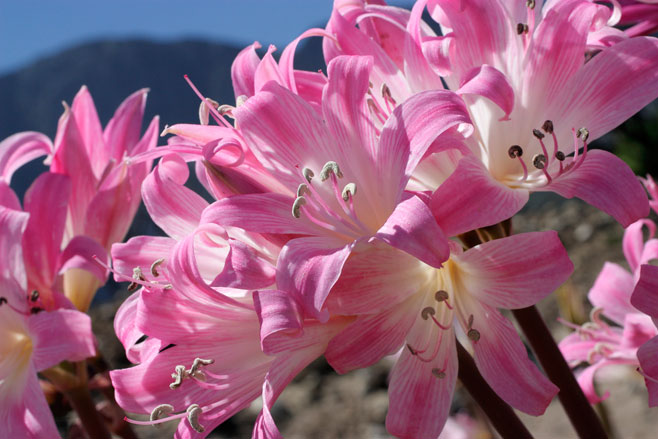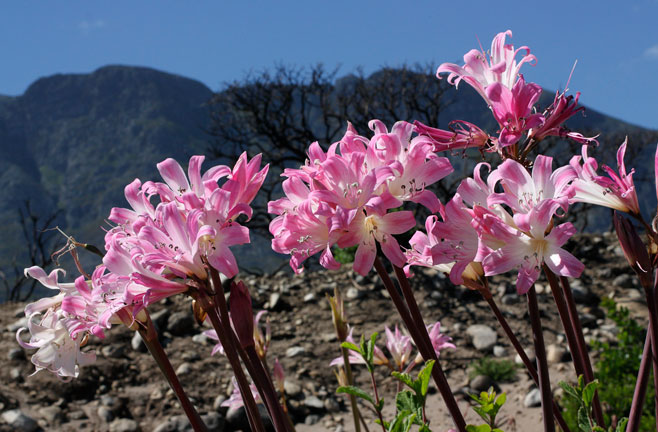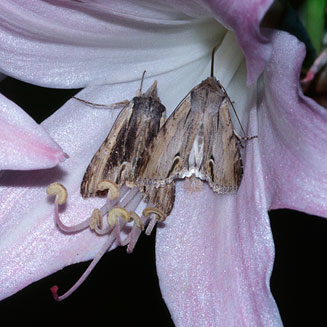|
Amaryllis belladonna (March
lily, Belladonna)
Maartlelie, Maartblom, Belladonnalelie [Afrikaans]
Life
> eukaryotes >
Archaeoplastida >
Chloroplastida
>
Charophyta > Streptophytina > Plantae (land plants)
> Tracheophyta (vascular plants) > Euphyllophyta > Lignophyta (woody plants)
> Spermatophyta (seed plants) > Angiospermae (flowering
plants)
> Monocotyledons > Order: Asparagales
> Family: Amaryllidaceae > Amaryllis
 |
 |
|
 |
|
Top and central photos: Amaryllis belladonna,
flowering a few weeks after a fire in fynbos at Kogel Bay, Western Cape,
South Africa. [photos
Colin Paterson-Jones ©]
Bottom photo: Amaryllis belladonna, Betty's
Bay, Western Cape, South Africa. [photo
H.G.
Robertson, Iziko ©] |
Distribution and habitat
Endemic to the Western Cape, South Africa, from Olifants
River Valley to Knysna, where it is found on lower slopes and flats in
seasonally moist sites with loamy soils. It is commonly cultivated and has
become naturalised in Mediterranean climates around the world (Manning et al.
2002).
Life cycle
- Amaryllis belladonna is a geophyte and has a massive bulb
measuring about 10 cm in diameter.
- Long, strap-like leaves are produced in winter and produce starch that
contributes to the growth of the bulb (Johnson and Snijman 1996). These
leaves die back in summer, leaving nothing behind.
- The flowering stem is produced from February to April (end of summer,
and autumn) when there are no leaves on the plant (the production of flowers
before leaves is termed hysteranthy). Flowers are particularly prominent in
March, hence the common name 'March lily'. In the mountain fynbos, flowering
is supressed when the vegetation is thick overhead so it is only after a
fire that most of the flowers appear. However, in more open sandy areas on
the flats, flowers appear annually within a stand of plants.
- Flowers are visited in the evening by noctuid moths and by Carpenter
bees in the daytime (see Ecological interactions below) but the relative
importance of these insects as pollinators has not yet been established.
- The seeds are large and heavy and are shaken loose from the plant by the
plant being blown about in the wind. Once on the ground, they start
germinating immediately, aided by the first winter rains that fall around
this time (Johnson and Snijman 1996). This lack of dispersal results in very
localised, dense concentrations of plants (Manning et al. 2002).
Ecological interactions
 |
|
| The moth
Cucullia extricata visiting
flowers of the Belladonna Lily (Amaryllis belladonna), Cape
Peninsula, South Africa. [photo
Colin Paterson-Jones ©] |
|
Flower visitors
- Insects
-
Lepidoptera
-
Noctuid moths. Flowers are particularly heavily scented in the
evening and it is then that they are visited by noctuid moths
(Manning et al. 2002).
-
Hymenoptera
- Xylocopa (carpenter bees). Visit flowers by day but
relatively few flowers within a population are visited by these bees
(Manning et al. 2002).
Herbivores
- Insects
-
Lepidoptera
-
Noctuidae
- Brithys pancratii. The black and white striped larvae
bore into the flowering stem and can cause it to collapse
(Johnson and Snijman 1996).
Medical importance
An alkaloid called
lycorine (=
narcissine) in the bulb affects the heart and if the bulb is eaten in quantity,
death can result.
Links
Publications
- Dyer, R.A. 1955. Amaryllis belladonna. Flowering
Plants of Africa 30: t. 1200.
- Johnson, S.D. and Snijman, D.A. 1996. Amaryllis belladonna.
Veld & Flora 82: 70-71.
- Tjaden, W. 1989. The fair Amaryllis. Garden 114: 345-348.
|
